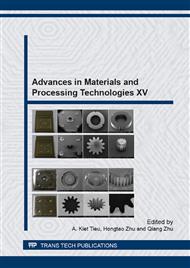[1]
K. Uehara, M. Sakurai, Bonding strength of adhesives and surface roughness of joined parts, Journal of Materials Processing Technology, 127 (2002) 178-181.
DOI: 10.1016/s0924-0136(02)00122-x
Google Scholar
[2]
T. Sekercioglu, H. Rende, A. Gülsöz, C. Meran, The effects of surface roughness on the strength of adhesively bonded cylindrical components, Journal of Materials Processing Technology, 142 (2003) 82-86.
DOI: 10.1016/s0924-0136(03)00463-1
Google Scholar
[3]
M.Shahid, S.A. Hashim, Effect of surface roughness on the strength of cleavage joints, International Journal of Adhesion & Adhesives, 22 (2002) 235-244.
DOI: 10.1016/s0143-7496(01)00059-8
Google Scholar
[4]
G. Rabilloud, High-Performance Polymers: Conductive Adhesives No. 1: Chemistry and Applications, Editions Technip, Paris, 1997.
Google Scholar
[5]
R. Kahraman, M. Sunar, B. Yilbas, Influence of adhesive thickness and filler content on the mechanical performance of aluminum single-lap joints bonded with aluminum powder filled epoxy adhesive, Journal of Materials Processing Technology, 205 (2008) 183-189.
DOI: 10.1016/j.jmatprotec.2007.11.121
Google Scholar
[6]
R. Kilik, R. Davies, Mechanical properties of adhesive filled with metal powders, Int J Adhesion and Adhesives, 9 (1989) 224-228.
DOI: 10.1016/0143-7496(89)90065-1
Google Scholar
[7]
J. Wang, Q. Guo, L. Liu, J. Song, The preparation and performance of high-temperature adhesives for graphite bonding, Int J Adhesion and Adhesives, 25 (2005) 495-501.
DOI: 10.1016/j.ijadhadh.2005.01.006
Google Scholar
[8]
L. Zhai, G. Ling, J. Li, Y. Wang, The effect of nanoparticles on the adhesion of epoxy adhesive, Materials Letters, 60 (2006) 3031-3033.
DOI: 10.1016/j.matlet.2006.02.038
Google Scholar
[9]
H. Zhao, K.Y.R. Li, Effect of water absorption on the mechanical and dielectric properties of nano-alumina filled epoxy nanocomposites, Composites: Part A, 39 (2008) 602-611.
DOI: 10.1016/j.compositesa.2007.07.006
Google Scholar
[10]
M. May, H.M. Wang, R. Akid, Effects of the addition of inorganic nanoparticles on the adhesive strength of a hybrid sol–gel epoxy system, Int J Adhesion and Adhesives, 30 (2010) 505-512.
DOI: 10.1016/j.ijadhadh.2010.05.002
Google Scholar
[11]
A.M. Bahattab, J. Donate-Robles, V. García-Pacios, J.M. Martín-Martínez, Characterization of polyurethane adhesives containing nanosilicas of different particle size, Int J Adhesion and Adhesives, 31 (2011) 97-103.
DOI: 10.1016/j.ijadhadh.2010.11.001
Google Scholar
[12]
European Standard EN 1465, Adhesives - Determination of tensile lap-shear strength of bonded assemblies, (2009)
DOI: 10.3403/30180285
Google Scholar
[13]
S. Khoee, N. Hassani, Adhesion strength improvement of epoxy resin reinforced with nanoelastomeric copolymer, Materials Science and Engineering A, 527 (2010) 6562-6567.
DOI: 10.1016/j.msea.2010.07.013
Google Scholar
[14]
ISO 468, Surface roughness-Parameters, their values and general rules for specifying requirements (1982)
Google Scholar
[15]
O. Lunder, B. Olsen, K. Nisancioglu, Pre-treatment of AA6060 aluminium alloy for adhesive bonding, International Journal of Adhesion & Adhesives, 22 (2002) 143-150.
DOI: 10.1016/s0143-7496(01)00049-5
Google Scholar
[16]
E. Sancaktar, R. Gomatam, A study on the effects of surface roughness on the strength of single lap joints, J. Adhesion Sci. Technol.,15 (2001) 97-117.
DOI: 10.1163/156856101743346
Google Scholar
[17]
L.F.M. Da Silva, R.D. Adams, M. Gibbs, Manufacture of adhesive joints and bulk specimens with high-temperature adhesives, International Journal of Adhesion & Adhesives, 24 (2004) 69-83.
DOI: 10.1016/s0143-7496(03)00101-5
Google Scholar
[18]
G. Habenicht, Applied Adhesive Bonding: A Practical Guide for Flawless Results. WILEY-VCH Verlag GmbH & Co. KGaA, Weinheim, 2009.
DOI: 10.1002/9783527626458
Google Scholar
[19]
TSE EN ISO 10365, Yapıştırıcılar- Başlıca Kusurların Gösterilmesi, (2001)
Google Scholar
[20]
iNEMI Nano Solder Project Work, www.inemi.org (2008)
Google Scholar
[21]
E. Wallner, D. Sarma, B. Myers, S. Shah, et al., SAE Technical Paper, (2010)
Google Scholar


